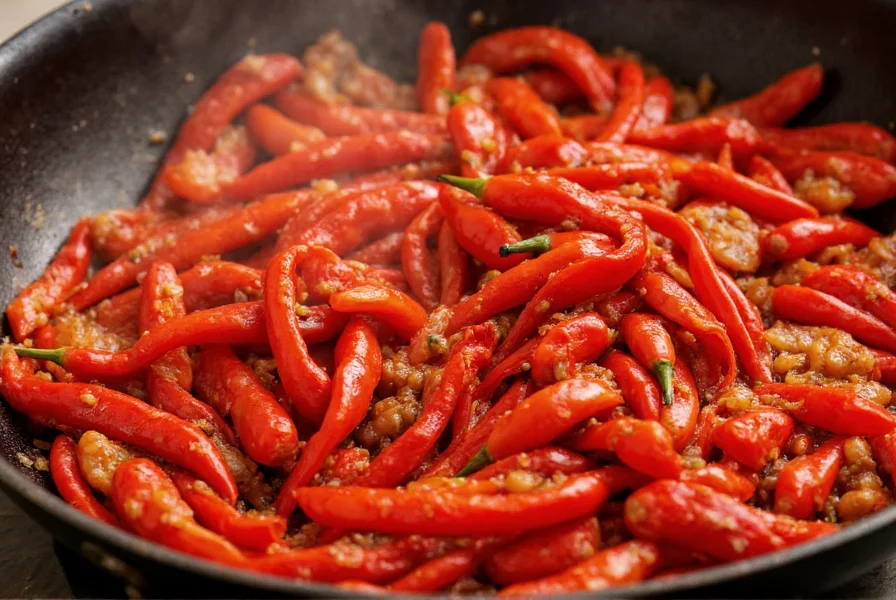Understanding Red Pepper Restaurant Menus
When searching for a red pepper menu, you're likely exploring dining options at restaurants specializing in spicy Asian cuisine. The term "red pepper" in restaurant names often signals a focus on bold, fiery flavors characteristic of Szechuan and Hunan Chinese cooking traditions. These establishments build their culinary identity around the distinctive heat and aroma of various red pepper varieties.
Common Menu Structure at Red Pepper Restaurants
Most red pepper-focused restaurants organize their menus with clear sections that highlight their pepper-centric specialties. Understanding this structure helps diners navigate their options effectively.
| Menu Section | Typical Red Pepper Dishes | Spice Level Indicator |
|---|---|---|
| Appetizers | Spicy wontons, chili edamame, pepper-dusted spring rolls | Mild to Medium |
| Main Courses | Kung Pao chicken, mapo tofu, dry-fried green beans with red peppers | Medium to Extra Hot |
| Signature Dishes | Whole fish with dried red peppers, spicy beef noodle soup | Hot to Extreme |
| Vegetarian Options | Spicy eggplant with garlic sauce, dry-fried string beans | Customizable |
Decoding Red Pepper Menu Terminology
Red pepper menus often include specific terminology that indicates how peppers are used in preparation. Understanding these terms helps manage spice expectations:
- Lazi (辣子) - Indicates dishes featuring dried red chilies as a primary ingredient
- Hong (红) - Refers to red-colored spicy sauces or preparations
- Mala (麻辣) - Describes the signature Szechuan flavor combining spiciness (ma) and numbing sensation (la)
- Gan guo (干锅) - "Dry pot" cooking method that intensifies pepper flavors
Regional Variations in Red Pepper Menus
Not all red pepper menus are identical. Regional differences significantly impact the spice profiles and dish selections:
Szechuan-style red pepper menus emphasize the mala sensation with generous use of Szechuan peppercorns alongside dried red chilies. Hunan cuisine focuses on fresh red peppers and garlic for a cleaner, more direct heat. Some Americanized versions offer "red pepper" dishes with significantly reduced spice levels to accommodate local palates while maintaining the visual appeal of red pepper garnishes.
How to Navigate a Red Pepper Menu Successfully
First-time diners often struggle with red pepper menus due to unfamiliar terminology and unpredictable spice levels. Consider these practical strategies:
Look for dishes specifically mentioning "red pepper" in their titles rather than general "spicy" designations. Many restaurants indicate heat levels with pepper icons - one pepper typically means mild, while three or more suggests extreme heat. Don't hesitate to ask staff about their signature red pepper dishes and whether they can adjust spice levels. Many establishments offer "red pepper tasting menus" that showcase their pepper-based specialties in a curated sequence.

Special Dietary Considerations
For those with specific dietary needs, red pepper menus present both challenges and opportunities. Many traditional red pepper dishes contain gluten (in sauces) or potential allergens. However, the emphasis on fresh ingredients in authentic preparations often makes modification possible. When ordering, specify any dietary restrictions clearly - most experienced red pepper restaurants can accommodate requests for gluten-free versions or reduced spice levels without compromising the essential pepper flavors.
Seasonal Red Pepper Specials
Authentic red pepper restaurants often feature seasonal menu items that highlight fresh pepper varieties at their peak. During summer months, you might find dishes featuring fresh red bell peppers and jalapeños, while winter menus often showcase dried red chilies and preserved pepper preparations. Some establishments even offer "pepper tasting events" where diners can sample different pepper varieties and learn about their unique flavor profiles.
Frequently Asked Questions
What does 'red pepper menu' typically refer to in restaurant contexts?
A red pepper menu refers to culinary offerings at Asian restaurants, particularly Chinese establishments specializing in Szechuan or Hunan cuisine, where red peppers serve as a signature ingredient. These menus feature dishes with varying spice levels that prominently incorporate dried red chilies, fresh peppers, and pepper-based sauces.
How can I identify authentic red pepper dishes on a menu?
Look for specific terminology like 'lazi' (indicating dried red chilies), 'gan guo' (dry pot cooking method), or dishes named after specific pepper varieties. Authentic red pepper dishes often list the type of pepper used and may include Chinese characters alongside English descriptions. Menu items featuring whole dried peppers in the description typically indicate authentic preparations.
Can I adjust the spice level on red pepper menu items?
Most authentic red pepper restaurants can adjust spice levels upon request, though this may alter the dish's traditional flavor profile. It's best to communicate your preference when ordering - many establishments use a pepper icon system (one to five peppers) to indicate heat levels. Some restaurants offer 'beginner,' 'traditional,' and 'authentic' spice level options for their red pepper specialty dishes.
What are the most popular vegetarian options on a red pepper menu?
Popular vegetarian options include dry-fried string beans with red peppers, spicy eggplant with garlic sauce, and mapo tofu (when prepared without meat). Many red pepper restaurants offer customizable vegetable stir-fries where you can specify the type and quantity of red peppers used. Look for dishes labeled 'vegetarian spicy delight' or 'red pepper vegetable medley' which typically feature multiple pepper varieties.










 浙公网安备
33010002000092号
浙公网安备
33010002000092号 浙B2-20120091-4
浙B2-20120091-4